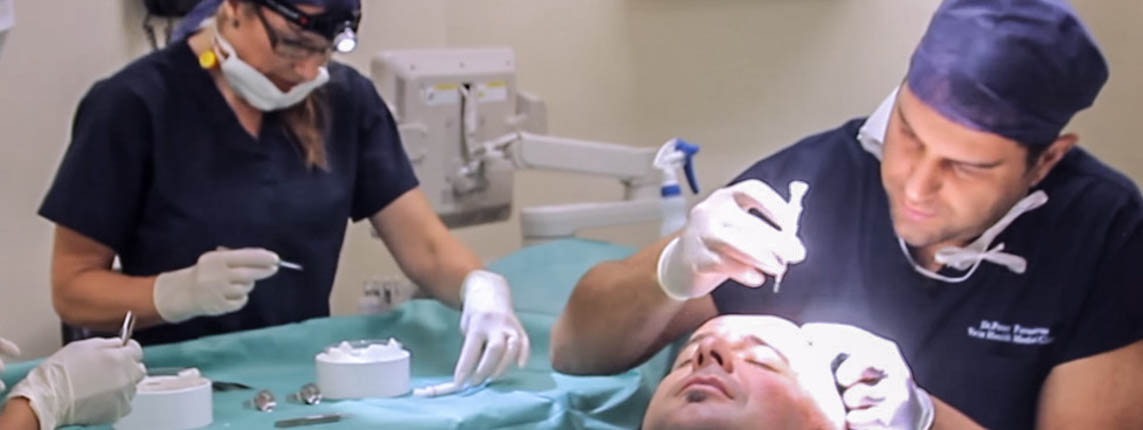Recreate your natural hairline with an FUE Hair Transplant.
What is an FUE hair transplant?
Follicular unit extraction (or FUE) involves removing groups of hair follicles, or follicular units, from a donor area of hair usually the back of the head. Follicular units naturally occur in clusters of one, two, three, or four hairs. Once removed from the back of the scalp, they are divided into smaller groups, then strategically implanted into the thinning area. This is done at a precise angle, in the direction of the curl, to create the most natural look when they grow.
The donor area is most often the back of the head. The regions typically affected by androgenetic alopecia in men (male pattern hair loss) are the hairline, top and vertex of the scalp, and the temples. Much of the hair growing on the back and sides of the head are resistant to the hormone that causes genetic hair loss. This region unaffected by the hormone is the ideal donor area from which to extract hair follicles for transplantation.
What can FUE do?
- Restore areas of balding or thinning on the scalp (e.g.: due to androgenetic alopecia or male/female pattern hair loss, etc)
- Restore areas of traumatic alopecia or traumatic hair loss (i.e.: burns, braiding, scarring, chemical damage)
- Reconstruct poorly designed or botched hair transplants
- Repair of scars from the FUT strip procedure
- Fill out sparse regions of the beard or facial hair
- Restore density to the eyebrows.
Advantages of the FUE technique
- You can wear your hair short at the back of the head.
- No intravenous or strong painkillers are necessary.
- Minimal post-operative recovery time. You can return to work the following day.
- No obvious linear scars.
- There are no stitches or staples to have removed.
- FUE can repair the appearance of FUT linear scars.
Am I a good candidate for this kind of hair transplantation?
We don’t go ahead with hair transplant surgery if it’s not right for you. Not everyone is suitable for an FUE transplant. We discuss this with you; balancing your hair restoration goals with the condition of the scalp, scarring, density of the donor area, quality of grafts, age, and hair loss to date to determine if this is the best option for you.
Interested in a consultation?
What's the difference between FUE and FUT hair transplants?
FUT strip surgery is another method of hair transplantation still in common use today. Where FUE entails extracting donor follicles one-by-one, FUT ( Follicular Unit Transplantation) cuts a long strip from the back of the scalp containing follicles. This strip is dissected into smaller groups of follicles to be implanted. The strip requires stitches or staples so it can heal and will likely leave a long linear scar that can be seen on short hairstyles.
Follicular Unit Extraction does have a longer procedure time than FUT, because of the time it takes to extract follicle units one by one. However, our preferred method is FUE because of its shorter recovery time, reduced pain, and lack of obvious scarring.
Recovery
You can return to work the day after FUE surgery. For 2 weeks after surgery, you will need to avoid vigorous hair combing, heavy exertion/exercise, swimming, or exposing your grafts to direct sunlight. After 2 weeks, you can return to your normal activities including exercise.
Is it permanent?
Once implanted, follicular units will grow naturally and permanently unless they have been traumatised during the hair transplantation or healing process. This hair can be treated the same way as the rest of your hair and can be styled, straightened, dyed, or curled.
Find out whether an FUE hair transplant is right for you
 How much does FUE hair transplant cost?
How much does FUE hair transplant cost?
FUE surgery is not performed in the same way at all hair transplant clinics. Price is important, but so are high standards of medical practice. Make sure you are well informed and ask the right questions before making your decision.
FAQs on FUE Hair Transplants
How long is the FUE procedure?
Extracting follicles from the donor area at the back of the scalp usually takes 2-3 hours and is followed by a rest period. Implanting the follicles into the recipient area takes another 2-3 hours. Most procedures take between 4 and 8 hours, depending on the number of follicles involved. The procedure time varies for other transplant treatment areas such as eyebrows, scars, beard transplant, etc. Talk to us for a time estimate for your procedure.
How long does new growth take?
At 6-9 weeks post-surgery, the transplanted hair often falls out. This is a normal part of the growth process although it can be a discouraging experience. The hair breaks off but the hair follicle under the skin is unharmed.
At approx. 3 months post-surgery, the hair will begin the active phase of the growth cycle and new growth will become visible. At 8-10 weeks, expect to see good growth. At first, the hair will be thin, but with time it will thicken up. Paras Hair Transplant will meet with you 6, 12, and 18 months after your procedure to check your progress.
Does FUE hurt?
FUE is performed under local anaesthetic so you won’t feel pain during the procedure. The hair follicle donor area and the transplant area are both numbed by the anaesthetic. Several hours afterward, you may experience mild soreness and swelling. the doctor will discuss managing this with you.
FUE Aftercare
You will be given a detailed explanation and written instructions on aftercare for your FUE hair restoration, including how to keep it clean and moist. The clinic will call you to check-in and will answer any more questions you have.
In the first week, the recipient area will look like a grazed knee. Scabs will form, it may bleed a little, and it may be itchy. Resist the urge to scratch, you don’t want to dislodge or damage any of the follicles. The scabs will fall off by themselves. When in the shower, don’t allow the water to fall straight onto your new hair grafts.
The donor area at the back of the scalp will heal in 3-4 days.
From 7 days onward, you can wash the recipient area as you normally would.
During the first two weeks, you must not do strenuous exercise, lift heavy weights, or swim, as this can risk damage to your new hair. Also, avoid brushing or combing your hair or being under direct sunlight. But after 14 days, you can return to your normal exercise routine.
After several weeks, the transplanted hair often falls out. Don’t panic, this is a normal part of the growth cycle for the transplanted grafts. The hair breaks off and falls out, but the follicle is alive-and-well beneath the skin. Soon after this hair fall, the next growth cycle will commence, and you will begin to see new growth coming through.
If you notice any ingrown hairs in the recipient area, i.e., red, pimply bumps, they usually clear up on their own and the grafts generally won’t have any ill effects. But if you have excessive ingrown hairs, please get in contact with the clinic immediately. As we may need to check them.
We take aftercare very seriously, and we are happy to discuss any concerns you have before, during, or after your procedure.
What are the side effects or risks of FUE?
Any surgical procedure carries risks. This will be discussed at your initial consultation and again on the day of the procedure.
Please note: Any surgical or invasive procedure carries risks.







